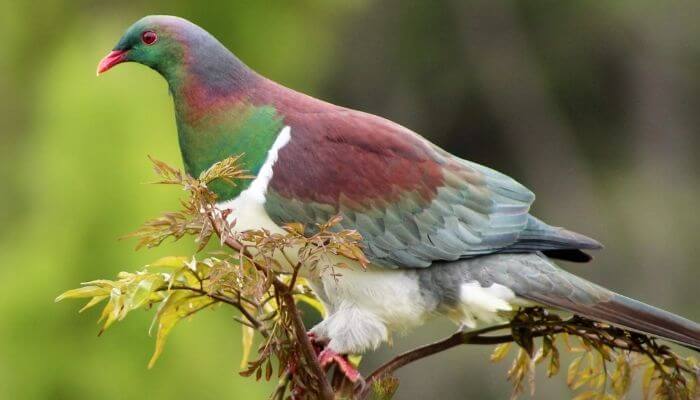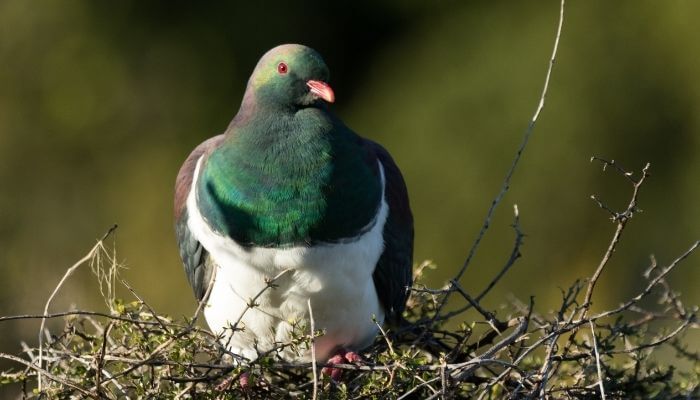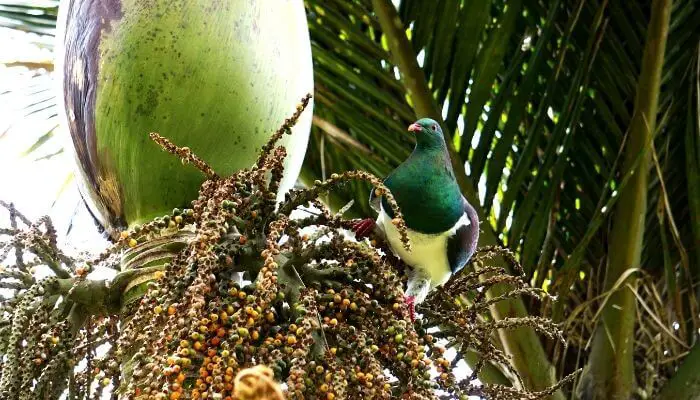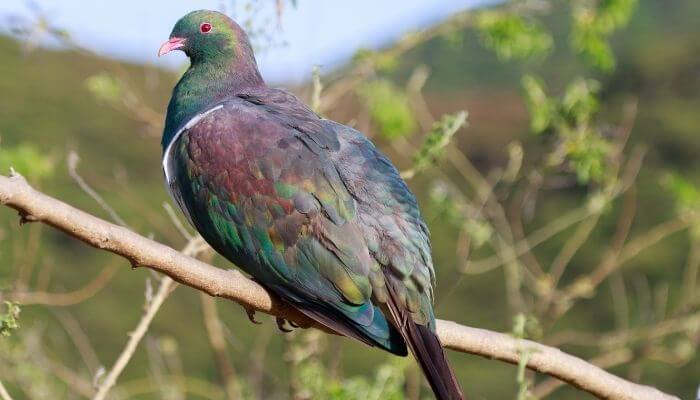The Kererū, also called the New Zealand pigeon, is a large pigeon with distinctive iridescent plumage.
Whether you’ve heard the kererū’s characteristic “coo” or seen one stumble and fall from a tree, this conspicuous bird has quite a tale to tell.

In this article, we cover everything you need to know about the kererū New Zealand Pigeon.
From its origin and habitat to why it’s regarded as one of the clumsiest birds in the world, the kererū leads an extremely interesting life.
Origin of the Kererū New Zealand Pigeon
As an Amazon Associate I earn a small fee from qualifying purchases made through Amazon links. This helps us run the site – thanks for your support.
The kererū (spelled kererū) is one of the most popular pigeons in New Zealand. It was first mentioned in John Latham’s book “A General Synopsis of Birds” in 1783.
However, it wasn’t until 1789 when Johann Friedrich Gmelin gave it a scientific name and formally described it as “glamorous, gluttonous, and extremely clumsy.”

It’s placed under the genus Hemiphaga, which loosely translates to “small fruit-eater.”
- Family: Columbidae
- Subfamily: Ptillinopinae
- Genus: Hemiphaga
- Species: H. novaeseelandiae
- Common name: New Zealand pigeon
Kererū Appearance
| Wingspan | Length | Weight | Coloring | |
|---|---|---|---|---|
| Kererū New Zealand Pigeon | Around 75cm | Around 50cm | 550 – 850g | Dark green, brown, white, and copper-sheened purple |
| Average Feral Pigeon | 64 – 72 cm | 32 – 37 cm | 300 – 500 g | Bluish grey with some black |
The kererū looks like your average pigeon.
It has a small head, red bill, dark red feet, and red eyes.
Both males and females have similar plumage.
Most of the pigeon’s body is dark green with some gold bronze. The lower back is gray-green, and the upper back is purple.

The “coo” sounds of the kererū are extremely characteristic.
They also make a distinctive “whoosh” sound with their wings when flying.
If you watch a kererū fly, you’ll notice that they ascend slowly then start making acrobatic dives to descend.
Kererū Habitat
Historically, the kererū was found all over New Zealand.
However, it’s now extinct in many regions due to cat predation and hunting.
It was also a major food source for the Māori people.
Since its classification as “near threatened” by the IUCN Red List, hunting kererū is now illegal, even for cultural reasons.

kererū live in parks, gardens, shrublands, lowland forests, and countrysides.
They generally live in one place their whole lives, although they can cover remarkable distances searching for food.
A study in 2011 showed that three kererū had traveled nearly 100 Kms from Invercargill and to Stewart Island, crossing the Foveaux Strait in the process.
Kererū Behavior
kererū are conspicuous but reclusive by nature.
They like to eat then rest under a canopy for several hours.
This changes entirely during the breeding season.
They start perching on high trees and the males start engaging in acrobatic flights to win over the females.
Kererū aren’t territorial.
However, they can become aggressive if other pigeons try to feed in the same food tree they’re eating from.
If a fight breaks out, a kererū will flap its wings to hit intruders, but nothing more.
Breeding New Zealand Pigeons
The kererū breeds throughout the year, but it generally lays eggs from September till April.
When there’s little to no food available, kererū will not breed until they find a source of food.
This explains why their population is easily destabilized when living conditions aren’t ideal.

The nest consists mainly of dead twigs.
Females lay a single egg and incubate it from the afternoon till the next morning.
Then, the male takes over for a couple of hours.
Chicks are typically brooded till they’re covered in feathers and about 10 days old.
The chicks start flying when they’re roughly 40 days old. Until then, they don’t leave their nests and wait for one of the parents to come and feed them.
Kererū Diet
Kererū are frugivorous, meaning they eat buds, flowers, leaves, and most notably, fruits.
Some of the fruits kererū eat include pigeonwood, taraire, tawa, and karaka.
They’re among the few bird species that can swallow the whole fruit in one go.
They’re well known for eating rotten fruits, becoming too intoxicated to function, and falling from trees. This has rightfully earned them the reputation as the drunkest pigeons in New Zealand (see the video below)!
Kererū would sometimes get so drunk that they’d need to be transferred to nearby wildlife centers to sober up.
When their favorite fruits aren’t abundant, kererū may eat leaves like tree lucerne, poplar, elm, and willow. They also eat nitrogen-rich foliage, especially in the breeding season.
Their Relationship With Humans
The Māori people have historically hunted kererū for their feathers and meat.
They’re considered a huge part of their cultural identity.
During Puanga celebrations, kererū was regarded as the food of choice because of how fat the pigeons are from eating the fermented fruits.
They were also intoxicated most of the time, which meant catching them was easier than any other bird.
In Māori culture, snaring is typically used to catch the unsuspecting pigeons.
In other cultures, spearing was also used to capture kererū.
Snaring is done by laying a trap suspended in a tree with snares next to a water trough.
The pigeon would land to drink to be captured by the snare.
Sometimes, tame kererū are placed in the trap to lure others to join.
When a kererū is caught, it’s preserved in a food container so it can sit in its own fat.
This method was so prevalent that, in 1882, it was reported that over 8000 pigeons were caught and preserved using this method.
Conservation Of The Kererū
The kererū is currently classified as “near threatened,” although efforts to restore the population have been largely successful.
Up until the 1960s, kererū were found nationwide and in large numbers.
However, due to habitat degradation, hunting, predation, and poor reproductive success, their numbers started to rapidly decline.
The brushtail possum is one of the most contributing factors in the population reduction of the kererū.
Possums and rats love to prey on nestlings and eggs, while stoats and cats can easily kill an adult kererū.

As the population of kererū started to decline rapidly, the Wild Birds Protection Act in 1864 banned hunting the New Zealand pigeon outside of the hunting season.
In 1922, the kererū was classified as an “absolutely protected species,” which effectively banned hunting Kererū at any time.
Finally, the Wildlife Act in 1953 re-established Kererū as a protected species and increased efforts to enforce the hunting ban.
Nowadays, Kererū populations are thriving in most of New Zealand.
The only regions where Kererū are still threatened are mainly due to poor predator control.
In bustling cities, you’ll find numerous road signs that caution drivers of running into Kererū.
This is mainly to protect the drivers, not the birds since the weight and size of the Kererū can cause serious harm to the motorists.
Endorsements
The Kererū was voted 2018’s bird of the year after a nationwide poll marginally favored the New Zealand pigeon.
With more than 48,000 votes cast, the Kererū got 5,833 votes, triumphing over the Kākāpō, with 3,772 votes, and the Kakī, with 2995 votes.
The competition’s highest voter turnout caused the kererū to receive celebrity endorsements from Bill Bailey, Stephen Fry, and even the prime minister herself:
I salute you, @Kereru4PM #BirdOfTheYear
— Jacinda Ardern (@jacindaardern) October 14, 2018
No bird has ever won more than once, but that didn’t stop dedicated pages on Twitter from asking voters to re-elect the kererū in the upcoming years.
You’ve probably heard of Tinder, and maybe even got a few matches yourself, but did you know there’s a Tinder profile of the New Zealand pigeon which has garnered over 500 matches so far?
In Conclusion
There are a lot of similar pigeons that look just like the Kererū, but no bird is nearly as interesting!
If you want to help make the kererū bird of the year again, join the official kererū page on Facebook and cast your vote before the next elections.
Until then, look out for drunk kererū falling from punga trees if you’re in New Zealand!
